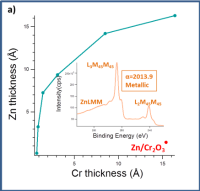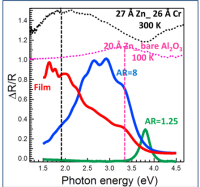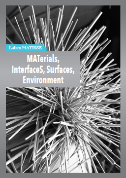Probing in situ the wetting at metal/oxide interface via plasmonics combined with photoemission

Axe 2 - Matériaux multifonctionnels et environnement
Thèse de Maya Messayekh
Travail de recherche initié me 1er octobre 2015. Cette thèse est cofinancée avec un partenaire industriel : Arcelor Mittal.
Soutenance le 9 novembre 2018 à 14h
Salle Herpin
Bâtiment Esclangon
Campus Pierre et Marie Curie
Sorbonne Université
Laboratoires co-porteurs
- Institut des NanoSciences de Paris (INSP)
Porteur du projet : Rémi Lazzari - ArcelorMittal Maizières Research
Co-encadrant : Alexey Koltsov
Projet de recherche
M. Messaykeh1, R. Lazzari1, J. Jupille1, G. Cabailh1, T.-H.L Le1, J. Goniakowski1, C. Noguera1, S. Chenot1, A. Koltsov2, J.-M. Mataigne2
1 Institut des NanoSciences de Paris, CNRS UMR7588, Sorbonne Universités, Université Paris VI, 75005 Paris, France
2 Arcelor Mittal Maizières Research, 57280 Maizières-lès-Metz, France
The in situ and real time characterization of the wetting of a surface by growing films is a crucial issue in surface science [1]. We address herein the case by combining plasmonics sensitivity to morphology (UV-vis Surface Differential Reflectivity Spectroscopy, SDRS [2]) and X-ray Photoelectron Spectroscopy (XPS) sensitivity to chemistry to study the effect of a metallic buffer (Cr) on a metal/oxide interface (Zn/-Al2O3(0001)). The system is inspired by the new Advanced High Strength Steel grades used in automotive industry of which drawback is to exhibit segregated oxide adlayers (here alumina) that prevent the adhesion of Zn in the galvanization process.
Our fundamental study performed at 300 K involves (i) Cr/Al2O3 film growth as function of thickness and (ii) deposition of Zn (16Å) overlayer on top. Cr allows Zn sticking on Al2O3 at 300 K while much lower temperature (100K) is required to reach a siz able condensation of Zn on bare alumina [2,3]. At early stages of growth, SDRS shows that Cr forms initially 3D clusters that cover partially the surface of alumina until an early percolation for kinetic reasons. Photoemission points at Cr in metallic state and the lack of reduction of alumina.Only a reaction limited to surface OH is detected. Concerning Zn sticking, the thickness of deposited Zn determined through XPS correlates with the Cr thickness (Fig. a). Both the shape of the Zn LMM Auger transition and the Auger parameter (=2013.9eV) highlight metallic zinc (Inset of Fig. a). Consistently, dielectric simulation of experimental SDRS of a Zn film grown over a thick Cr deposit that completely covers alumina (Fig. b) reveals a 2D morphology (that contrasts with the 3D growth on alumina at 100 K, Fig. b) in agreement with ab initio predictions on Zn/Cr/Al2O3 [4]. Finally, Zn is shown to poorly wet oxidized Cr. The contrasted behavior of Zn wetting over metallic and oxidized Cr highlights the interest of optics and photoemission combination in the case of the in situ study of the wetting/adhesion during the growth of thin films.
[1] G. Renaud et al. , Science 300 (2003) 1416.
[2] R. Lazzari et al. , J. Phys. Chem. C 118 (2014) 7032.
[3] Le et al, J. Phys. Chem. C accepted (2017)
[4] Le et al. , J. Phys. Chem. C 120 (2016) 9836.


Conférences et interventions
- Présentation orale
ECOSS, 2017
Probing in situ the wetting at metal/oxide interface via plasmonics combined with photoemission - Présentation poster
Journées Scientifiques du Comité Spectroscopie d'Electrons
Fundamental approach of wetting at Zn/Al2O3 interface
Egalement dans la rubrique
MATISSE en chiffres
- 4 disciplines : Chimie, Physique, Sciences de la Terre, Patrimoine
- 400 permanents
Contact
Direction
Florence Babonneau
Administration
Communication
Emmanuel Sautjeau



